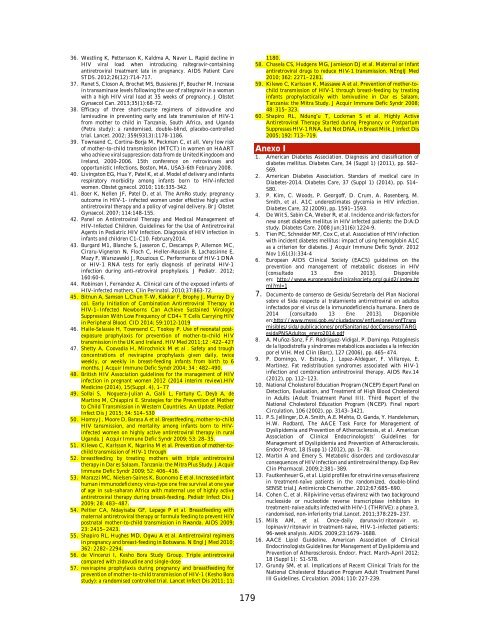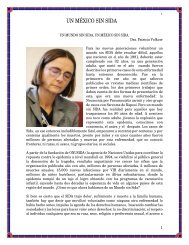GUÍA MANEJO ANTIRRETROVIRAL PERSONAS VIH
G_ARV2016_1
G_ARV2016_1
You also want an ePaper? Increase the reach of your titles
YUMPU automatically turns print PDFs into web optimized ePapers that Google loves.
36. Westling K, Pettersson K, Kaldma A, Naver L. Rapid decline in<br />
HIV viral load when introducing raltegravir-containing<br />
antiretroviral treatment late in pregnancy. AIDS Patient Care<br />
STDS. 2012;26(12):714-717.<br />
37. Renet S, Closon A, Brochet MS, Bussieres JF, Boucher M. Increase<br />
in transaminase levels following the use of raltegravir in a woman<br />
with a high HIV viral load at 35 weeks of pregnancy. J Obstet<br />
Gynaecol Can. 2013;35(1):68-72.<br />
38. Efficacy of three short-course regimens of zidovudine and<br />
lamivudine in preventing early and late transmission of HIV-1<br />
from mother to child in Tanzania, South Africa, and Uganda<br />
(Petra study): a randomised, double-blind, placebo-controlled<br />
trial. Lancet. 2002; 359(9313):1178-1186.<br />
39. Townsend C, Cortina-Borja M, Peckman C, et all. Very low risk<br />
of mother-to-child transmission (MTCT) in women on HAART<br />
who achieve viral suppression: data from de United Kingdoom and<br />
Ireland, 2000-2006. 15th conference on retroviruses and<br />
opportunistic Infections, Boston, MA, USA3-6th February 2008.<br />
40. Livingston EG, Hua Y, Patel K, et al. Model of delivery and infants<br />
respiratory morbidity among infants born to HIV-infected<br />
women. Obstet gynecol. 2010; 116:335-342.<br />
41. Boer K, Nellen JF, Patel D, et al. The AmRo study: pregnancy<br />
outcome in HIV-1- infected women under effective higly active<br />
antiretroviral therapy and a policy of vaginal delivery. Br J Obstet<br />
Gynaecol. 2007; 114:148-155.<br />
42. Panel on Antiretroviral Therapy and Medical Management of<br />
HIV-Infected Children. Guidelines for the Use of Antiretroviral<br />
Agents in Pediatric HIV Infection. Diagnosis of HIV infection in<br />
infants and children C1-C10. February2014.<br />
43. Burgard M1, Blanche S, Jasseron C, Descamps P, Allemon MC,<br />
Ciraru-Vigneron N, Floch C, Heller-Roussin B, Lachassinne E,<br />
Mazy F, Warszawski J, Rouzioux C. Performance of HIV-1 DNA<br />
or HIV-1 RNA tests for early diagnosis of perinatal HIV-1<br />
infection during anti-retroviral prophylaxis. J Pediatr. 2012;<br />
160:60-6.<br />
44. Robinson l, Fernandez A. Clinical care of the exposed infants of<br />
HIV-infected mothers. Clin Perinatol. 2010;37:863-72.<br />
45. Bitnun A, Samson L,Chun T-W, Kakkar F, Brophy J, Murray D y<br />
col. Early Initiation of Combination Antiretroviral Therapy in<br />
HIV-1–Infected Newborns Can Achieve Sustained Virologic<br />
Suppression With Low Frequency of CD4+ T Cells Carrying HIV<br />
in Peripheral Blood. CID 2014; 59:1012-1019<br />
46. Haile-Selassie H, Townsend C, Tookey P. Use of neonatal postexposure<br />
prophylaxis for prevention of mother-to-child HIV<br />
transmission in the UK and Ireland. HIV Med 2011;12 : 422–427<br />
47. Shetty A, Coovadia H, Mirochnick M et al . Safety and trough<br />
concentrations of nevirapine prophylaxis given daily, twice<br />
weekly, or weekly in breast-feeding infants from birth to 6<br />
months. J Acquir Immune Defic Syndr 2004; 34 : 482–490.<br />
48. British HIV Association guidelines for the management of HIV<br />
infection in pregnant women 2012 (2014 interim review).HIV<br />
Medicine (2014), 15(Suppl. 4), 1–77<br />
49. Sollai S, Noguera-Julian A, Galli L, Fortuny C, Deyà A, de<br />
Martino M, Chiappini E. Strategies for the Prevention of Mother<br />
to Child Transmission in Western Countries. An Update. Pediatr<br />
Infect Dis J 2015; 34: S14–S30<br />
50. Homsy J, Moore D, Barasa A et al. Breastfeeding, mother-to-child<br />
HIV tansmission, and mortality among infants born to HIVinfected<br />
women on highly active antiretroviral therapy in rural<br />
Uganda. J Acquir Immune Defic Syndr 2009; 53: 28–35.<br />
51. Kilewo C, Karlsson K, Ngarina M et al. Prevention of mother-tochild<br />
transmission of HIV-1 through<br />
52. breastfeeding by treating mothers with triple antiretroviral<br />
therapy in Dar es Salaam, Tanzania: the Mitra Plus Study. J Acquir<br />
Immune Defic Syndr 2009; 52: 406–416.<br />
53. Marazzi MC, Nielsen-Saines K, Buonomo E et al. Increased infant<br />
human immunodeficiency virus-type one free survival at one year<br />
of age in sub-saharan Africa with maternal use of highly active<br />
antiretroviral therapy during breast-feeding. Pediatr Infect Dis J<br />
2009; 28: 483–487.<br />
54. Peltier CA, Ndayisaba GF, Lepage P et al. Breastfeeding with<br />
maternal antiretroviral therapy or formula feeding to prevent HIV<br />
postnatal mother-to-child transmission in Rwanda. AIDS 2009;<br />
23: 2415–2423.<br />
55. Shapiro RL, Hughes MD, Ogwu A et al. Antiretroviral regimens<br />
in pregnancy and breast-feeding in Botswana. N Engl J Med 2010;<br />
362: 2282–2294.<br />
56. de Vincenzi I, Kesho Bora Study Group. Triple antiretroviral<br />
compared with zidovudine and single-dose<br />
57. nevirapine prophylaxis during pregnancy and breastfeeding for<br />
prevention of mother-to-child transmission of HIV-1 (Kesho Bora<br />
study): a randomised controlled trial. Lancet Infect Dis 2011; 11:<br />
1180.<br />
58. Chasela CS, Hudgens MG, Jamieson DJ et al. Maternal or infant<br />
antiretroviral drugs to reduce HIV-1 transmission. NEnglJ Med<br />
2010; 362: 2271–2281.<br />
59. Kilewo C, Karlsson K, Massawe A et al. Prevention of mother-tochild<br />
transmission of HIV-1 through breast-feeding by treating<br />
infants prophylactically with lamivudine in Dar es Salaam,<br />
Tanzania: the Mitra Study. J Acquir Immune Defic Syndr 2008;<br />
48: 315–323.<br />
60. Shapiro RL, Ndung’u T, Lockman S et al. Highly Active<br />
Antiretroviral Therapy Started during Pregnancy or Postpartum<br />
Suppresses HIV-1 RNA, but Not DNA, in Breast Milk. J Infect Dis<br />
2005; 192: 713–719.<br />
Anexo I<br />
1. American Diabetes Association. Diagnosis and classification of<br />
diabetes mellitus. Diabetes Care, 34 (Suppl 1) (2011), pp. S62–<br />
S69.<br />
2. American Diabetes Association. Standars of medical care in<br />
Diabetes-2014. Diabetes Care, 37 (Suppl 1) (2014), pp. S14–<br />
S80.<br />
3. P. Kim, C. Woods, P. Georgoff, D. Crum, A. Rosenberg, M.<br />
Smith, et al. A1C underestimates glycemia in HIV infection.<br />
Diabetes Care, 32 (2009), pp. 1591–1593.<br />
4. De Wit S, Sabin CA, Weber R, et al. Incidence and risk factors for<br />
new onset diabetes mellitus in HIV infected patients: the D:A:D<br />
study. Diabetes Care. 2008 Jun;31(6):1224-9.<br />
5. Tien PC, Schneider MF, Cox C, et al. Association of HIV infection<br />
with incident diabetes mellitus: impact of using hemoglobin A1C<br />
as a criterion for diabetes. J Acquir Immune Defic Syndr. 2012<br />
Nov 1;61(3):334-4<br />
6. European AIDS Clinical Society (EACS) guidelines on the<br />
prevention and management of metabolic diseases in HIV<br />
[consultado 13 Ene 2013]. Disponible<br />
en: http://www.europeanaidsclinicalsociety.org/guid2/index.ht<br />
ml?ml=1<br />
7. Documento de consenso de Gesida/Secretaría del Plan Nacional<br />
sobre el Sida respecto al tratamiento antirretroviral en adultos<br />
infectados por el virus de la inmunodeficiencia humana. Enero de<br />
2014 [consultado 13 Ene 2013]. Disponible<br />
en:http://www.msssi.gob.es/ciudadanos/enfLesiones/enfTrans<br />
misibles/sida/publicaciones/profSanitarios/docConsensoTARG<br />
esidaPNSAdultos_enero2014.pdf<br />
8. A. Muñoz-Sanz, F.F. Rodriguez-Vidigal, P. Domingo. Patogénesis<br />
de la lipodistrofia y síndromes metabólicos asociados a la infección<br />
por el <strong>VIH</strong>. Med Clin (Barc), 127 (2006), pp. 465–474.<br />
9. P. Domingo, V. Estrada, J. Lopez-Aldeguer, F. Villaroya, E.<br />
Martinez. Fat redistribution syndromes associated with HIV-1<br />
infection and combination antiretroviral therapy. AIDS Rev.14<br />
(2012), pp. 112–123.<br />
10. National Cholesterol Education Program (NCEP) Expert Panel on<br />
Detection, Evaluation, and Treatment of High Blood Cholesterol<br />
in Adults (Adult Treatment Panel III). Third Report of the<br />
National Cholesterol Education Program (NCEP). Final report<br />
Circulation, 106 (2002), pp. 3143–3421.<br />
11. P.S. Jellinger, D.A. Smith, A.E. Mehta, O. Ganda, Y. Handelsman,<br />
H.W. Rodbard, The AACE Task Force for Management of<br />
Dyslipidemia and Prevention of Atherosclerosis, et al. American<br />
Association of Clinical Endocrinologists’ Guidelines for<br />
Management of Dyslipidemia and Prevention of Atherosclerosis.<br />
Endocr Pract, 18 (Supp 1) (2012), pp. 1–78.<br />
12. Martin A and Emery S. Metabolic disorders and cardiovascular<br />
consequences of HIV infection and antiretroviral therapy. Exp Rev<br />
Clin Pharmacol. 2009;2:381–389.<br />
13. Fautkenheuer G, et al. Lipid profiles for etravirine versus efavirenz<br />
in treatment-naïve patients in the randomized, double-blind<br />
SENSE trial.J Antimicrob Chemother. 2012;67:685–690.<br />
14. Cohen C, et al. Rilpivirine versus efavirenz with two background<br />
nucleoside or nucleotide reverse transcriptase inhibitors in<br />
treatment-naive adults infected with HIV-1 (THRIVE): a phase 3,<br />
randomised, non-inferiority trial.Lancet. 2011;378:229–237.<br />
15. Mills AM, et al. Once-daily darunavir/ritonavir vs.<br />
lopinavir/ritonavir in treatment-naive, HIV-1-infected patients:<br />
96-week analysis. AIDS. 2009;23:1679–1688.<br />
16. AACE Lipid Guideline. American Association of Clinical<br />
Endocrinologists Guidelines for Management of Dyslipidemia and<br />
Prevention of Atherosclerosis. Endocr. Pract. March-April 2012;<br />
18 (Suppl 1): S1-S78.<br />
17. Grundy SM, et al. Implications of Recent Clinical Trials for the<br />
National Cholesterol Education Program Adult Treatment Panel<br />
III Guidelines. Circulation. 2004; 110: 227-239.<br />
179



